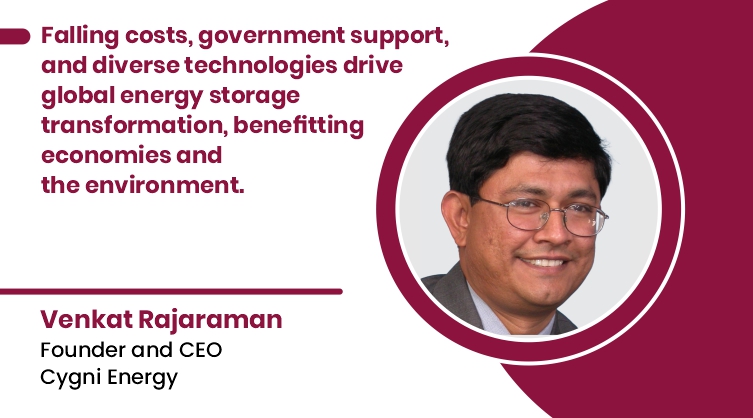Energy storage enriches grid reliability with renewable
By EPR Magazine Editorial November 4, 2023 9:05 pm IST
By EPR Magazine Editorial November 4, 2023 9:05 pm IST

Falling costs, government support, and diverse technologies drive global energy storage transformation, benefitting economies and the environment.
Energy storage technology rapidly transforms the energy sector, driving sustainability and grid reliability. Innovations are reducing costs, enhancing performance, and promoting a cleaner, more resilient energy future. Venkat Rajaraman speaks about the aspects of energy storage.
What is changing in energy storage technology and its impact on the energy landscape?
Energy storage technology is rapidly evolving, revolutionising the energy sector. Innovations in materials and safety measures are reducing environmental and health hazards. Faster charging, longer cycle life, and solid-state batteries are enhancing performance, enabling the integration of renewables, grid stability, and electric vehicle adoption. This transformation leads to cleaner, more reliable power sources, reduced greenhouse gas emissions, and improved grid resilience, promoting sustainability and shifting towards a greener, more efficient energy future.
How does energy storage enhance grid reliability, especially with renewables and extreme weather?
Energy storage bolsters grid reliability, particularly when integrating renewable sources and during extreme weather events. It smooths out the variable output of renewables like wind and solar by storing excess energy during peak generation and releasing it when demand is high, ensuring a consistent power supply. This helps avoid blackouts and enhances grid stability. During extreme weather, energy storage provides critical backup power, supporting essential services when the grid is compromised. It can also create microgrids, ensuring localised power generation and resilience. Additionally, energy storage aids in frequency regulation, ensuring the grid’s stability and minimising the risk of power disruptions during adverse conditions.
How does energy storage align with sustainability goals, and what is being done to reduce its environmental footprint?Energy storage is a linchpin in pursuing sustainability goals, as it underpins integrating renewable energy and enhances energy system efficiency. By storing excess energy when renewable sources like wind and solar are abundant and releasing it when needed, energy storage reduces the dependence on fossil fuels and curbs greenhouse gas emissions. It helps stabilise the grid, ensuring a reliable power supply while promoting cleaner energy sources. However, it’s crucial to address the environmental footprint of energy storage technologies. To reduce their environmental impact, extensive research and development efforts focus on several key areas. These include battery recycling programs to recover valuable materials, sustainable materials innovation, and the development of more energy-efficient systems.
How are falling storage costs affecting industries and economies?
Declining energy storage costs are revolutionising the energy landscape. Affordable storage bolsters renewable energy reliability, curbs emissions, and spurs renewable sector growth. It fortifies grid resilience, shielding against power disruptions. Moreover, it propels the electric vehicle market, lessening fossil fuel dependence and boosting EV-related industries. Industries are adopting storage for efficient energy use, cutting costs and environmental impact. Government policies, incentives, and R&D funding are pivotal in lowering costs, advancing sustainability, and fostering economic growth across sectors.
Spokesperson– Venkat Rajaraman, Founder and CEO – Cygni Energy
We use cookies to personalize your experience. By continuing to visit this website you agree to our Terms & Conditions, Privacy Policy and Cookie Policy.